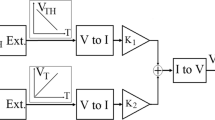Abstract
A low power CMOS voltage reference with process compensation is presented in TSMC 0.18-μm standard CMOS technology. Detailed analysis of the process compensation technique is discussed. The circuit is simulated with Spectre. Simulation results show that, without any trimming procedure, the output voltage achieves a maximum deviation of 0.35 % across different process corners. The temperature coefficient of the proposed circuit is 12.7 ppm/°C in a temperature range from −40 to 85 °C and the line sensitivity is 0.036 mV/V with a supply voltage range from 1.2 to 2.5 V under typical condition. The maximum supply current is 390.4 nA at maximum supply voltage and −40 °C. The power supply rejection ratio is −68.3 dB at 100 Hz and 2.5 V without any filtering capacitor.















Similar content being viewed by others
References
Doyle, J., Lee, Y. J., Kim, Y.-B., Wilsch, H., & Lombardi, F. (2004). A CMOS subbandgap reference circuit with 1-V power supply voltage. IEEE Journal of Solid-State Circuits, 39(1), 252–255.
Sanborn, K., Ma, D., & Ivanov, V. (2007). A sub-1-V low-noise bandgap voltage reference. IEEE Journal of Solid-State Circuits, 42(11), 2466–2481.
Ivanov, V., Brederlow, R., & Gerber, J. (2012). An ultra low power bandgap operational at supply from 0.75 V. IEEE Journal of Solid-State Circuits, 47(7), 1515–1523.
Wu, J., Chen, C., Shen, H., Huang, C., & Liu, H. (2013). A high PSRR CMOS voltage reference with 1.2 V operation. Analog Integrated Circuits and Signal Processing, 77(1), 79–86.
Giustolisi, G., Palumbo, G., Criscione, M., & Cutri, F. (2003). A low-voltage low-power voltage reference based on subthreshold MOSFETs. IEEE Journal of Solid-State Circuits, 38(1), 151–154.
Ueno, K., Hirose, T., Asai, T., & Amemiya, Y. (2009). A 300 nW, 15 ppm/°C, 20 ppm/V CMOS voltage reference Circuit consisting of subthreshold MOSFETs. IEEE Journal of Solid-State Circuits, 44(7), 2047–2054.
De Vita, G., & Iannaccone, G. (2007). A sub-1-V, 10 ppm/°C, nanopower voltage reference generator. IEEE Journal of Solid-State Circuits, 42(7), 1536–1542.
Zhou, Z., Zhu, P., Shi, Y., Wang, H., Ma, Y., et al. (2012). A CMOS voltage reference based on mutual compensation of Vtn and Vtp. IEEE Transactions on Circuits and Systems II: Express Briefs, 59(6), 341–345.
Magnelli, L., Crupi, F., Corsonello, P., Pace, C., Iannaccone, G., & Crupi, F. (2011). A 2.6 nW, 0.45 V temperature-compensated subthreshold CMOS voltage reference. IEEE Journal of Solid-State Circuits, 46(2), 465–474.
Sul, H., Jun, Y., & Kong, B. (2010). A temperature-stabilized voltage reference utilizing MOS body effect. In 2010 IEEE Asia Pacific conference on circuits and systems (pp. 792–795).
Leung, K. N., & Mok, P. K. T. (2003). A CMOS voltage reference based on weighted ΔVGS for CMOS low-dropout linear regulators. IEEE Journal of Solid-State Circuits, 38(1), 146–150.
De Vita, G., & Iannaccone, G. (2005). An ultra-low-power, temperature compensated voltage reference generator. In Proceedings of the IEEE 2005, custom integrated circuits conference (pp. 751–754).
De Vita, G., Iannaccone, G., & Andreani, P. (2006). A 300 nW, 12 ppm/°C voltage reference in a digital 0.35-μm CMOS process. In 2006 Symposium on VLSI circuits, 2006. Digest of Technical Papers (pp. 81–82).
Seok, M., Kim, G., Blaauw, D., & Sylvester, D. (2012). A portable 2-transistor picowatt temperature-compensated voltage reference operating at 0.5 V. IEEE Journal of Solid-State Circuits, 47(10), 2534–2545.
Yan, W., Li, W., & Liu, R. (2009). Nanopower CMOS sub-bandgap reference with 11 ppm/°C temperature coefficient. Electronics Letters, 45(12), 627–629.
Zhou, Z., Zhu, P., Shi, Y., Qu, X., Wang, H., et al. (2013). A resistorless CMOS voltage reference based on mutual compensation of VT and VTH. IEEE Transactions on Circuits and Systems II: Express Briefs, 60(9), 586–682.
Razavi, B. (2000). Design of analog CMOS integrated circuits. New York: McGraw-Hill.
Filanovsky, I. M., & Allam, A. (2001). Mutual compensation of mobility and threshold voltage temperature effects with applications in CMOS circuits. IEEE Transactions on Circuits and Systems I: Fundamental Theory and Applications, 48(7), 876–884.
Ma, H., & Zhou, F. (2009). A sub-1 V 115 nA 0.35 µm CMOS voltage reference for ultra low-power applications. In Proceedings of IEEE of the ASIC, ASICON ‘09. IEEE 8th international conference on ASIC (pp. 1074–1077).
Acknowledgments
This work was funded by the special funds for the development of Internet of things of Wuxi in China under project contracts No. 0414B011601130083PB.
Author information
Authors and Affiliations
Corresponding author
Rights and permissions
About this article
Cite this article
Xie, L., Liu, J., Wang, Y. et al. A low power CMOS voltage reference generator with temperature and process compensation. Analog Integr Circ Sig Process 81, 313–324 (2014). https://doi.org/10.1007/s10470-014-0360-7
Received:
Revised:
Accepted:
Published:
Issue Date:
DOI: https://doi.org/10.1007/s10470-014-0360-7




